

CLISP - an ANSI Common Lisp Implementation. Finding Lisp - Packages. Resolver Resolver is a UFFI interface to Linux's libresolv.so DNS library. Resolver allows you to query any type of DNS record and returns the full contents of a DNS reply packet, decoded in list format. Resolver is basically the Lisp equivalent of the Linux dig utility. History / Changelog Version 0.1 -- April 27, 2004 -- Initial attempt at ASDF-Install packaging. Installation You can install Resolver using ASDF-Install.
. * (require :asdf) * (require :asdf-install) * (asdf-install:install :resolver) If you are not using ASDF-Install, you can download the tarball here. Usage Unfortunately, there is no documentation for Resolver yet. . * (require :asdf) * (require :resolver) * (use-package :resolver) * (lookup "findinglisp.com" :mx) ;; etc... If you're using ASDF, but not SBCL, you will probably have to do something like. ALU: index. Edi Weitz. LibCL. Let Over Lambda. Macros Lisp's core occupies some kind of local optimum in the space of programming languages.
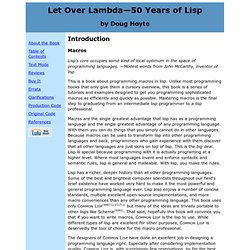
—Modest words from John McCarthy, inventor of lisp This is a book about programming macros in lisp. Unlike most programming books that only give them a cursory overview, this book is a series of tutorials and examples designed to get you programming sophisticated macros as efficiently and quickly as possible.
LISP Information and Resources. The Best Lisp links on the net!!!! Lisp!

Tutorials. LISP - Quick Reference. Planet Lisp. Lisp Resource Kit. The Lisp Resource Kit is a dedicated development/learning environment on a self-booting CD.
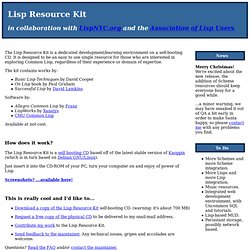
It is designed to be an easy to use single resource for those who are interested in exploring Common Lisp, regardless of their experience or domain of expertise. The kit contains works by: Basic Lisp Techniques by David Cooper On Lisp book by Paul Graham Successful Lisp by David Lamkins Software by: Allegro Common Lisp by FranzLispWorks by XanalysCMU Common Lisp Available at not cost. How does it work? The Lisp Resource Kit is a self booting CD based off of the latest stable version of Knoppix (which is in turn based on Debian GNU/Linux). Just insert it into the CD-ROM of your PC, turn your computer on and enjoy of power of Lisp. Screenshots? This is really cool and I'd like to... Learning Lisp for CMPT 310. You will be coding in the Common LISP programming language for your assignments.
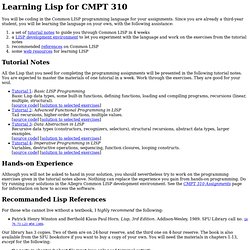
Since you are already a third-year student, you will be learning the language on your own, with the following assistance: a set of tutorial notes to guide you through Common LISP in 4 weeks a LISP development environment to let you experiment with the language and work on the exercises from the tutorial notes recommended references on Common LISP some web resources for learning LISP Tutorial Notes All the Lisp that you need for completing the programming assignments will be presented in the following tutorial notes.
You are expected to master the materials of one tutorial in a week. Hands-on Experience Although you will not be asked to hand in your solution, you should nevertheless try to work on the programming exercises given in the tutorial notes above. Recommanded Lisp References For those who cannot live without a textbook, I highly recommend the following: Guy L. Other Links. Lisp Programs For Beginners. I saw the InteractiveFiction project over in CeeProgramsForBeginners and, seeing some of the code there, was reminded why I have been learning lisp.
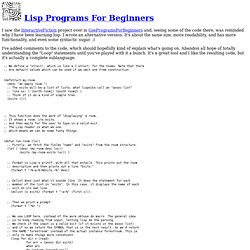
I wrote an alternative version. It's about the same size, more readability, and has more functionality, and even some syntactic sugar. :) I've added comments to the code, which should hopefully kind of explain what's going on. Abandon all hope of totally understanding the "Loop" statements until you've played with it a bunch. It's a great tool and I like the resulting code, but it's actually a complete sublanguage. ;; We define a "struct", which is like a C struct, for the rooms.
This was a surprisingly fun little thing that I took a while to write. CategoryLispCategoryExampleCategoryInManyProgrammingLanguages. Structure and Interpretation of Computer Programs, Video Lectures. Common Lisp/First steps/Beginner tutorial. Start up your Lisp implementation.
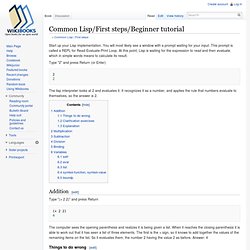
You will most likely see a window with a prompt waiting for your input. This prompt is called a REPL for Read-Evaluate-Print Loop. At this point, Lisp is waiting for the expression to read and then evaluate, which in simple words means to calculate its result. Type "2" and press Return (or Enter) The lisp interpreter looks at 2 and evaluates it. Addition[edit] Type "(+ 2 2)" and press Return The computer sees the opening parenthesis and realizes it is being given a list. Things to do wrong[edit] Forget to type return. (+2 2) Illegal function call Think it's a typo and try: +(2 2) Illegal function call Think it's a typo and do the infix thing. Index. 6.001 - Structure and Interpretation of Computer Programs - Fall 2005. This page is your entry to the course material.
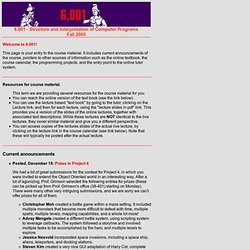
It includes current announcements of the course, pointers to other sources of information such as the online textbook, the course calendar, the programming projects, and the entry point to the online tutor system. Resources for course material. Posted, December 15: Prizes in Project 4 We had a lot of great submissions for the contest for Project 4, in which you were invited to extend the Object Oriented world in an interesting way. After a lot of agonizing, Prof. Grimson selected the following entries for prizes (these can be picked up from Prof. The following links contain information that is of value in understanding the content and organization of the course.